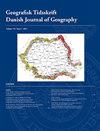评估服务提供对达累斯萨拉姆住宅的速度和中短期发展模式的影响
IF 1.1
4区 社会学
Q4 ENVIRONMENTAL STUDIES
Geografisk Tidsskrift-Danish Journal of Geography
Pub Date : 2018-07-03
DOI:10.1080/00167223.2018.1500490
引用次数: 7
摘要
城市发展模式、住房和服务提供之间的联系至关重要,因为它影响撒哈拉以南非洲城市稀缺资源的分配,在那里采用的规划模式和概念似乎很少成功。通过空间分析和定量研究,本研究探讨了达累斯萨拉姆市资源匮乏背景下服务和住房发展顺序对城市空间增长模式的影响。研究发现,尽管家庭土地所有权在城市向住宅所有权的空间扩张过程中起着至关重要的作用,但其实际建设和占用将取决于服务的可及性。此外,可以确定的是,随着提供更多的服务,按比例在新地区定居的人数也会增加。由于这一过程在规划和非规划住区中同样发生,本研究表明,是服务的可得性而不是土地分配触发了住宅的实际发展。因此,服务提供决定了中短期城市空间格局的变化速度。这意味着,在公共资源匮乏和自助住房的背景下,对电力连接、公共交通和饮用水等基本服务的战略投资是影响城市实际发展模式的方式,而不是提供地块。本文章由计算机程序翻译,如有差异,请以英文原文为准。
Assessing the influences of service provision on pace and short and medium term development patterns of residential housing in Dar es Salaam
ABSTRACT The connection between city development patterns, housing and service provision is critical as it affects allocation of scarce resources in the cities of Sub Sahara Africa, where the adopted planning models and concepts seem to have minimal success. Through spatial analysis and quantitative research this study explores sequencing of servicing and housing development as it impacts city spatial growth patterns in a context of resource deficiency in Dar es Salaam City. The study finds that despite households’ land ownership being crucial in city spatial expansion process towards residential house ownership, their actual construction and occupation will depend on the accessibility of services. Moreover, it was established that as more services become available, proportionally, number of people settling in new areas increases. Since this process happens equally in planned and unplanned settlements, this study indicates that it is the availability of services and not land allocation that triggers actual development of residential housing. Thus, service provision determines the pace of change in short and medium city spatial patterns. This implies that in the context of public resource deficiency and self-help housing, strategic investments in basic services such as electricity connection, public transport and portable water is the way to influence actual city development pattern rather than providing plots.
求助全文
通过发布文献求助,成功后即可免费获取论文全文。
去求助
来源期刊
CiteScore
5.20
自引率
0.00%
发文量
5
期刊介绍:
DJG is an interdisciplinary, international journal that publishes peer reviewed research articles on all aspects of geography. Coverage includes such topics as human geography, physical geography, human-environment interactions, Earth Observation, and Geographical Information Science. DJG also welcomes articles which address geographical perspectives of e.g. environmental studies, development studies, planning, landscape ecology and sustainability science. In addition to full-length papers, DJG publishes research notes. The journal has two annual issues. Authors from all parts of the world working within geography or related fields are invited to publish their research in the journal.

 求助内容:
求助内容: 应助结果提醒方式:
应助结果提醒方式:


